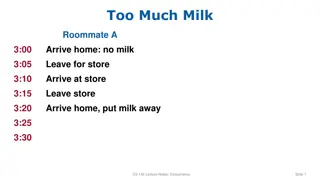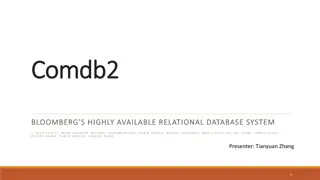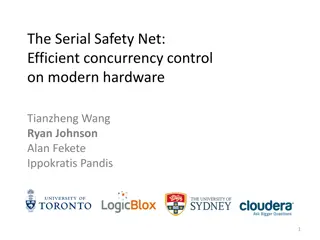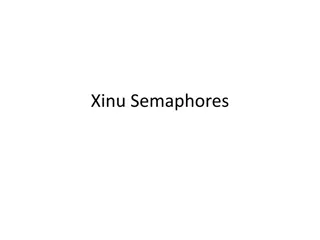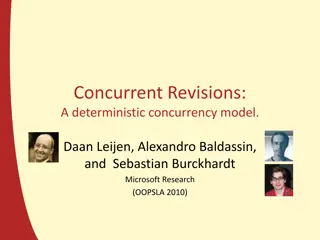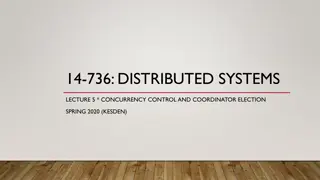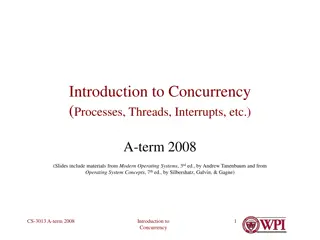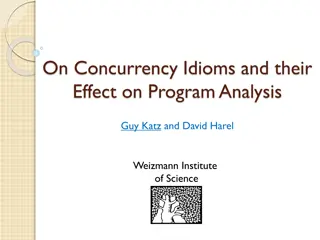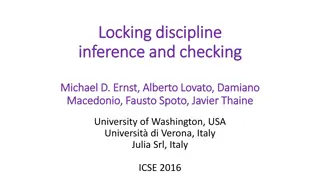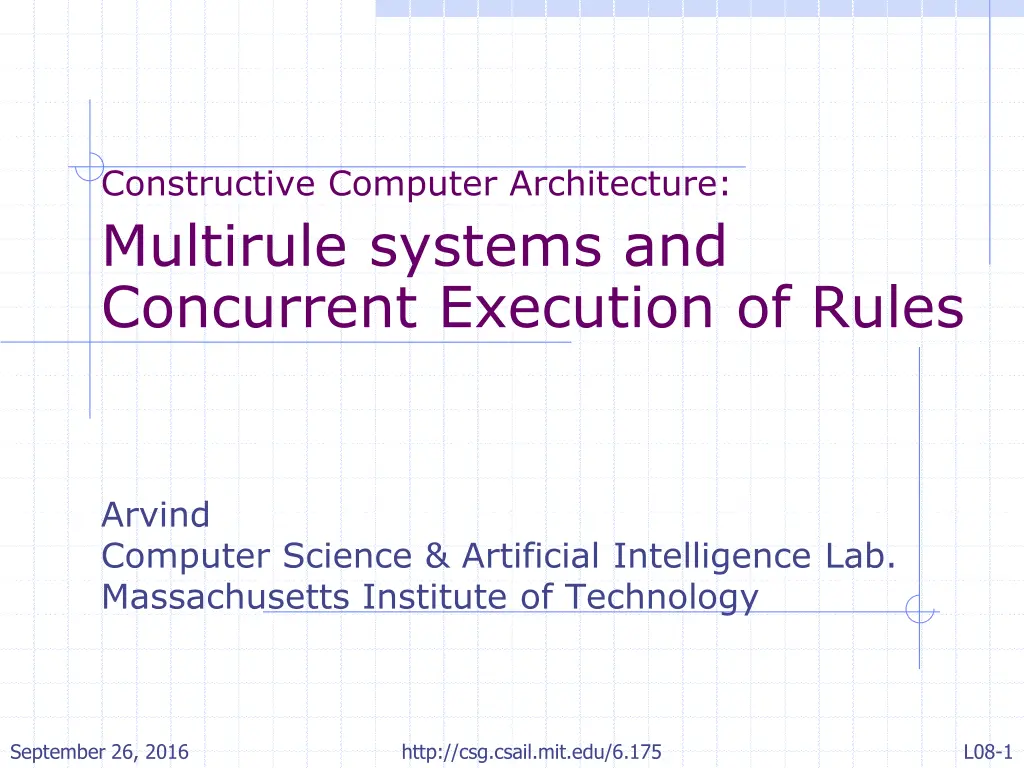
Concurrent Execution in Computer Architecture
Explore the concept of multirule systems and concurrent rule execution in computer architecture, comparing single-rule and multi-rule elastic pipelines. Understand how these systems function, their state changes, and the potential for concurrent rule execution for performance optimization.
Download Presentation

Please find below an Image/Link to download the presentation.
The content on the website is provided AS IS for your information and personal use only. It may not be sold, licensed, or shared on other websites without obtaining consent from the author. If you encounter any issues during the download, it is possible that the publisher has removed the file from their server.
You are allowed to download the files provided on this website for personal or commercial use, subject to the condition that they are used lawfully. All files are the property of their respective owners.
The content on the website is provided AS IS for your information and personal use only. It may not be sold, licensed, or shared on other websites without obtaining consent from the author.
E N D
Presentation Transcript
Constructive Computer Architecture: Multirule systems and Concurrent Execution of Rules Arvind Computer Science & Artificial Intelligence Lab. Massachusetts Institute of Technology September 26, 2016 http://csg.csail.mit.edu/6.175 L08-1
Rewriting Elastic pipeline as a multirule system f0 f1 f2 x inQ fifo1 fifo2 outQ rule stage1; if(inQ.notEmpty && fifo1.notFull) begin fifo1.enq(f0(inQ.first)); inQ.deq; end endrule rule stage2; if(fifo1.notEmpty && fifo2.notFull) begin fifo2.enq(f1(fifo1.first)); fifo1.deq; end endrule rule stage3; if(fifo2.notEmpty && outQ.notFull) begin outQ.enq(f2(fifo2.first)); fifo2.deq; end endrule How does such a system function? L08-2 http://csg.csail.mit.edu/6.175 September 26, 2016
Bluespec Execution Model Repeatedly: Select a rule to execute Compute the state updates Make the state updates Highly non- deterministic; User annotations can be used in rule selection One-rule-at-a-time-semantics: Any legal behavior of a Bluespec program can be explained by observing the state updates obtained by applying only one rule at a time However, for performance we need to execute multiple rules concurrently if possible L08-3 http://csg.csail.mit.edu/6.175 September 26, 2016
Multi-rule versus single rule elastic pipeline rule elasticPipeline; if(inQ.notEmpty && fifo1.notFull) begin fifo1.enq(f1(inQ.first)); inQ.deq; end if(fifo1.notEmpty && fifo2.notFull) begin fifo2.enq(f2(fifo1.first)); fifo1.deq; end if(fifo2.notEmpty && outQ.notFull) begin outQ.enq(f3(fifo2.first)); fifo2.deq; end endrule rule stage1; if(inQ.notEmpty && fifo1.notFull) begin fifo1.enq(f1(inQ.first)); inQ.deq; end endrule rule stage2; if(fifo1.notEmpty && fifo2.notFull) begin fifo2.enq(f2(fifo1.first)); fifo1.deq; end endrule rule stage3; if(fifo2.notEmpty && outQ.notFull) begin outQ.enq(f3(fifo2.first)); fifo2.deq; end endrule f1 f2 f3 x inQ fifo1 fifo2 outQ How are these two systems the same (or different)? http://csg.csail.mit.edu/6.175 L08-4 September 26, 2016
Elastic pipeline Do these systems see the same state changes? The single rule system fills up the pipeline and then processes a message at every pipeline stage for every rule firing no more than one slot in any fifo would be filled unless the OutQ blocks The multirule system has many more possible states. It can mimic the behavior of one-rule system but one can also execute rules in different orders, e.g., stage1; stage1; stage2; stage1; stage3; stage2; stage3; (assuming stage fifos have more than one slot) When can some or all the rules in a multirule system execute concurrently? L08-5 http://csg.csail.mit.edu/6.175 September 26, 2016
Can these rules execute in parallel? (without violating the one-rule-at-a-time-semantics) Example 3 Example 2 Example 1 rule ra; if (z>10) x <= x+1; endrule rule ra; if (z>10) x <= y+1; endrule rule ra; if (z>10) x <= y+1; endrule rule rb; if (z>20) y <= y+2; endrule rule rb; if (z>20) y <= y+2; endrule rule rb; if (z>20) y <= x+2; endrule No, C Yes, CF Yes, ra < rb L08-6 http://csg.csail.mit.edu/6.175 September 26, 2016
some insight into Concurrent rule execution rule Ri Rj Rk Rules steps Rj Rk HW clocks Ri There are more intermediate states in the rule semantics (a state after each rule step) In the HW, states change only at clock edges L08-7 http://csg.csail.mit.edu/6.175 September 26, 2016
Parallel execution reorders reads and writes Rules reads rule writes reads writes reads writes reads writes reads writes steps reads writes reads writes clocks HW In the rule semantics, each rule sees (reads) the effects (writes) of previous rules In the HW, rules only see the effects from previous clocks, and only affect subsequent clocks L08-8 http://csg.csail.mit.edu/6.175 September 26, 2016
Correctness rule Ri Rj Rk Rules steps Rj Rk HW clocks Ri The compiler will schedule rules concurrently only if the net state change is equivalent to sequential rule execution (which is what our theorem ensures) L08-9 http://csg.csail.mit.edu/6.175 September 26, 2016
Evaluating or applying a rule The state of the system s is defined as the value of all its registers An expression is evaluated by computing its value on the current state An action defines the next value of some of the state elements based on the current value of the state A rule is evaluated by evaluating the corresponding action and simultaneously updating all the affected state elements x y z ... rule x y z ... Given action a and state S, let a(S) represent the state after the application of action a L08-10 http://csg.csail.mit.edu/6.175 September 26, 2016
One-rule-at-a-time semantics Given a program with a set of rules {rule ri ai} and an initial state S0 , S is a legal state if and only if there exists a sequence of rules rj1, ., rjn such that S= ajn( (aj1(S0)) ) L08-11 http://csg.csail.mit.edu/6.175 September 26, 2016
Concurrent execution of two rules Concurrent execution of two rules, rule r1 a1 and rule r2 a2, means executing a rule whose body looks like (a1; a2), that is a rule which is a parallel composition of the actions of the two rules with the following restrictions to preserve the one-rule-at-a-time semantics: Either S. (a1; a2)(S) = a2(a1(S)) or S. (a1; a2)(S) = a1(a2(S)) L08-12 http://csg.csail.mit.edu/6.175 September 26, 2016
Concurrent scheduling of rules rule r1 a1 to rule rn an can be scheduled concurrently, preserving one-rule-at-a-time semantics, if and only if there exists a permutation (p1, ,pn) of (1, ,n) such that S. (a1; ;an)(S) = apn( (ap1(S)) L08-13 http://csg.csail.mit.edu/6.175 September 26, 2016
A compiler can determine if two rules can be executed in parallel without violating the one-rule- at-a-time semantics James Hoe, Ph.D., 2000 Construct a conflict matrix (CM) for rules September 26, 2016 http://csg.csail.mit.edu/6.175 L08-14
Extending CM to rules CM between two rules is computed exactly the same way as CM for the methods of a module Given rule r1 a1 and rule r2 a2 such that mcalls(a1)={g11,g12...g1n} mcalls(a2)={g21,g22...g2m} Compute Conflict(x,y) = if x and y are methods of the same module then CM[x,y] else CF CM[r1,r2] = conflict(g11,g21) conflict(g11,g22) ... conflict(g12,g21) conflict(g12,g22) ... conflict(g1n,g21) conflict(g12,g22) ... Conflict relation is not transitive r1 < r2, r2 < r3 does not imply r1 < r3 L08-15 http://csg.csail.mit.edu/6.175 September 26, 2016
Using CMs for concurrent scheduling of rules Two rules that are conflict free can be scheduled together without violating the one-rule-at-a-time semantics. In general, we use the following theorem Theorem: Given a set of rules {rule ri ai}, if there exists a permutation {p1, p2 pn} of {1..n} such that i < j. CM(api, apj) is CF or < thenthe rules r1, r2 rn can be scheduled concurrently with the effect i, j. rpi < rpj L08-16 http://csg.csail.mit.edu/6.175 September 26, 2016
Example 2: Compiler Analysis mcalls(ra) = {z.r, x.w, y.r} mcalls(rb) = {z.r, y.w, x.r} rule ra; if (z>10) x <= y+1; endrule CM(ra, rb) = conflict(z.r, z.r) conflict(z.r, y.w) conflict(z.r, x.r) conflict(x.w, z.r) conflict(x.w, y.w) conflict(x.w, x.r) conflict(y.r, z.r) conflict(y.r, y.w) Conflict(y.r, x.r) rule rb; if (z>20) y <= x+2; endrule = {>} {<} = C Rules ra and rb cannot be scheduled together without violating the one- rule-at-a-time-semantics L08-17 http://csg.csail.mit.edu/6.175 September 26, 2016
Example 3: Compiler Analysis mcalls(ra) = {z.r, x.w, y.r} mcalls(rb) = {z.r, y.w, y.r} rule ra; if (z>10) x <= y+1; endrule CM(ra, rb) = conflict(z.r, z.r) conflict(z.r, y.w) conflict(z.r, y.r) conflict(x.w, z.r) conflict(x.w, y.w) conflict(x.w, y.r) conflict(y.r, z.r) conflict(y.r, y.w) Conflict(y.r, y.r) rule rb; if (z>20) y <= y+2; endrule = {<} CF = {<} Rules ra and rb can be scheduled together without violating the one-rule-at-a-time-semantics. Rule ra < rb L08-18 http://csg.csail.mit.edu/6.175 September 26, 2016
Multi-rule versus single rule elastic pipeline rule elasticPipeline; if(inQ.notEmpty && fifo1.notFull) begin fifo1.enq(f1(inQ.first)); inQ.deq; end if(fifo1.notEmpty && fifo2.notFull) begin fifo2.enq(f2(fifo1.first)); fifo1.deq; end if(fifo2.notEmpty && outQ.notFull) begin outQ.enq(f3(fifo2.first)); fifo2.deq; end endrule f1 f2 f3 x inQ fifo1 fifo2 outQ rule stage1; if(inQ.notEmpty && fifo1.notFull) begin fifo1.enq(f1(inQ.first)); inQ.deq; end endrule rule stage2; if(fifo1.notEmpty && fifo2.notFull) begin fifo2.enq(f2(fifo1.first)); fifo1.deq; end endrule rule stage3; if(fifo2.notEmpty && outQ.notFull) begin outQ.enq(f3(fifo2.first)); fifo2.deq; end endrule If we do concurrent scheduling in the multirule system then the multi-rule system behaves like the single rule system http://csg.csail.mit.edu/6.175 September 26, 2016 L08-19
Concurrency when the FIFOs do not permit concurrent enq and deq f1 f2 f3 x inQ not empty fifo1 not empty & not full fifo2 not empty & not full outQ not full At best alternate stages in the pipeline will be able to fire concurrently L08-20 http://csg.csail.mit.edu/6.175 September 26, 2016



